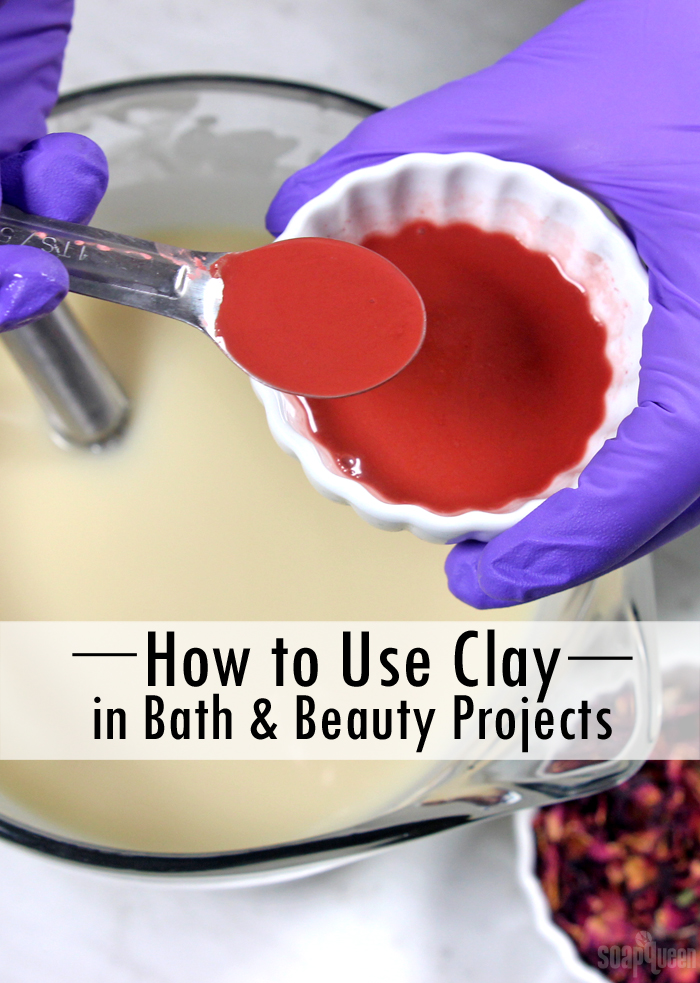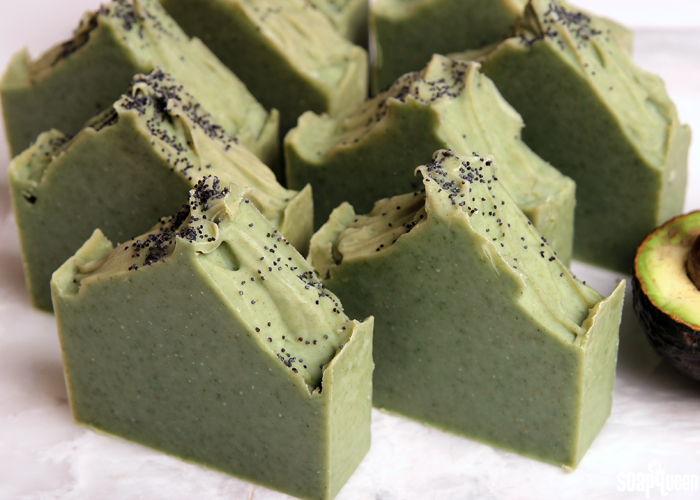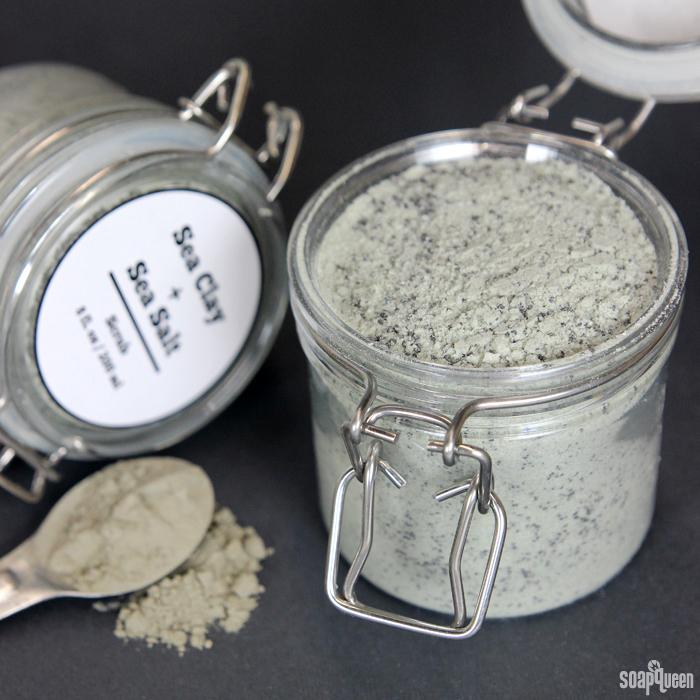
Clay is a versatile ingredient for a wide variety of bath and beauty projects. It’s probably most well known for clay face masks, but can also be used in cold process soap and scrubs. It adds color and various oil absorbing properties. If you’d like to add clay to your homemade beauty projects, find out which clay is right for your skin. Then, learn how to add it to various projects below.
Clay in Cold Process Soap
Because of their ability to absorb liquid, including oil, clays are a popular additive for soap created for oily skin. If you’d like to add clay to your soap projects, keep those properties in mind; clay also absorbs moisture in soap. To compensate for the moisture clay absorbs, disperse it in distilled water (rather than oil) for cold process soap recipes. The usage rate is 1 tablespoon distilled water per teaspoon of clay. In general, a usage rate of about 1 teaspoon of clay per pound of soap is a great place to start for cold process soap recipes. Feel free to use more if you’d like, just keep in mind clays also speed up trace. The more you use, the faster your soap will become thick. Learn more about trace here. Check out the recipes below for inspiration.
 The French green clay used in the Avocado + Spearmint Cold Process Soap helps give it a soft green color.
The French green clay used in the Avocado + Spearmint Cold Process Soap helps give it a soft green color.
- Lavender & Lemongrass Hot Process Soap – contains green zeolite clay
- Brine and Rose Clay Cold Process Soap – contains rose clay
- Lavender and Rose Pink Salt Bars – contain rose clay
- Natural Colorant Taiwan Swirl – contains dark red Brazilian clay
- Honey Bee Soap – contains yellow silt clay, purple Brazilian clay and dark red Brazilian clay
- Avocado + Spearmint Cold Process Soap – contains French green clay
- Waves of the Sea Cold Process Soap – contains sea clay
Clay in Melt and Pour
Clays are great for melt and pour soap as well. To help avoid clumps, disperse the clay in 99% isopropyl alcohol at a rate of 1 tablespoon alcohol to 1 teaspoon clay. They give soap great color and absorption properties. Unlike cold process soap, you don’t need to worry about it thickening the “trace” of melt and pour, but don’t use too much. Adding too much clay to melt and pour soap can make it more difficult to work with. One teaspoon of clay per pound of melt and pour soap is a great place to start. Continue adding clay to the melt and pour until you reach your desired effect.
 A combination of spirulina powder and green zeolite clay create a soft green color in the Star Anise Melt & Pour Bars.
A combination of spirulina powder and green zeolite clay create a soft green color in the Star Anise Melt & Pour Bars.
- Star Anise Melt & Pour Bars – contain green zeolite clay
- Minty Clay Melt & Pour Bars – contain green zeolite clay
- Tea Tree & Rosemary Cleansing Bar – contains green zeolite clay
- Charcoal & Rose Clay Spa Bar – contains rose clay
- Melt & Pour Clay Tutorial – contains yellow, dark red and purple Brazilian clays
Clay in Scrubs
Clays make a wonderful addition to body and face scrubs. This is especially true if the scrub is designed for oily skin, as clays pull oil from the skin. Because clays are fine grained, they usually don’t add much exfoliation to scrubs. But, they are fantastic additives for color and oil absorption. If your scrub is dry (does not contain any water or oil), simply add and mix the clay in with the other dry ingredients. If you’re mixing the clay into oil, keep in mind the clay can fall to the bottom of the oil and may need to be mixed up before use. In emulsified scrubs, dispersing the clay in a small amount of water or oil in your recipe can help avoid chunks, but is not completely necessary.
 In the Sea Clay Dry Salt Scrub, a combination of sea clay, baking soda, salts and poppy seeds make a scrubby paste when mixed with water.
In the Sea Clay Dry Salt Scrub, a combination of sea clay, baking soda, salts and poppy seeds make a scrubby paste when mixed with water.
- Walnut Facial Scrub for Men – contains kaolin clay
- Sea Clay Dry Salt Scrub – contains sea clay
- Rose Clay Sugar Scrub – contains rose clay
Clay in Bath Bombs
Clays can be added to bath bombs. Just keep in mind that clays are essentially dirt. If too much clay is added to the fizzy, it can leave a residue on the skin or the tub. Clays are great for giving bath bombs color, and can also help them hold their shape. In particular, kaolin clay is a popular clay choice due to the fine texture and neutral color. Kaolin clay can add structure and sturdiness to bath bombs. This help them hold their shape when unmolded, and is a popular additive for large bath bombs.
Because clays absorb, they can lead to a dry and crumbly bath bomb, so be careful to not use too much. This is especially true if you live in a very dry climate. A good place to start is about 1 tablespoon of kaolin clay per cup of bath bomb mixture. Add the clay to the dry ingredients and mix thoroughly prior to adding liquid ingredients to make the mixing process easier.
 Pink Brazilian clay and purple Brazilian clay give the Lavender & Clay Mondo Bath Fizzy stripes of color.
Pink Brazilian clay and purple Brazilian clay give the Lavender & Clay Mondo Bath Fizzy stripes of color.
- Mini Heart Bath Bombs – contain pink Brazilian clay
- Lavender & Clay Mondo Bath Fizzy – contains purple and pink Brazilian clays
Clay in Face Masks and Other Products
Because clay is so good at absorbing oil, it’s commonly used in products formulated for oily skin. A popular clay beauty product is clay face masks. The masks can be “dry,” meaning water is added to the powder to make a paste and applied to the skin. Clays can also be mixed with oil for a more hydrating experience, or emulsified for a lotion-like texture. If you’re designing a clay mask, find out which one is best suited for your skin here. For some clay mask recipe ideas, check out the Soap Queen TV video below.
- Shaving Soap Tutorial – contains bentonite clay
- Easy Whipped Shaving Soap Recipe – contains bentonite clay
- Rose Clay Exfoliating Mask – contains rose clay and kaolin clay
- Rose Clay Foot Mask – contains rose clay and kaolin clay
- Oatmeal Facial Scrub & Mask – contains bentonite clay
What’s your favorite way to incorporate clay into your handmade beauty projects?





I am looking to make my own sea salt spray and would like to add kaolin white clay to it. what ratio to water would you recommend?
Clay will separate from a water based solution because it is so heavy so we wouldn’t recommend it in a product like that.
hi can you put clay into body lotion bars?
You most definitely can add in the clay of your choice, just be sure that you’re sticking to a skin-safe ratio that won’t cause staining.
Can you use kaolin clay in hot process soap at the same ratio, 1 teaspoon of clay to 1 pound of soap? You’ve already noted that clay will speed up trace so should I expect the same in hot process?
Yes, you can use kaolin clay in hot process as well. It will speed trace up in hot process. Instead of adding at the beginning, you can add it when the soap is finished cooking. The water mixed with clay can help smooth out the soap for a few minutes so it’s easier to get into the mold.
Hi,
What is the maximum amount of clay we can add to Cold process soap like a spa bar or ordinary one.? Other than trace what effect will it have to the behavior of soap, like lather /moisturizing property?
I would start with 1 teaspoon per pound and see how you like it. If you add too much clay it can accelerate your trace and make a dry chalky bar.
Hi,
I am making bath bombs for my girls. It says 1 tablespoon in 1 cup of bath bomb mixture. Can you help with measurement standard of tablespoon and cup?
Warm regards,
Kanika
A tablespoon and a cup are a U.S. unit of measurement. You can convert to another volume measurement by typing “1 cup in liters” into a search engine like Google.
Hi there! I’m loving all the awesome information on your website! I’m planning to make a CP soap with french green clay, a swirl of activated charcoal, and tea tree and lavender essential oils, with the idea that these ingredients will make a great facial soap for oily and acne prone skin. My question is, can I disperse the green clay in witch hazel (the alcohol free kind), or another hydrosol, instead of distilled water? Also, do I need to account for the extra liquid in the lye calculation, or do I add it in addition to however much water I need according to the lye calculator? Thanks in advance for the help! 🙂
You can mix the clay with a hydrosol or witch hazel. It may accelerate or do other odd things in the soap, so you may want to make a small test batch to see how it performs. If it’s moving too fast, you can use distilled water instead. As for the water discount, if you add a fairly small amount to the clay – less than an ounce or so – it shouldn’t affect the batch too much. The clay absorbs a lot of that liquid so you don’t end up adding a lot. If you’re adding a few ounces, you can discount that from your main batch so it doesn’t get too wet.
Learn more about water discounting here: http://www.soapqueen.com/bath-and-body-tutorials/tips-and-tricks/water-discounting-cold-process-soap-how-why/
-Kelsey with Bramble Berry
Thank you so much for the quick reply! I’ll let you know how it goes, as I’ll be making the batch today or tomorrow. 🙂
Sounds good!
-Kelsey with Bramble Berry
Hi, I have some Indian healing clay, was curious how it would do in bath bombs. Also if you have any face mask recipes that use Indian healing clay! Thanks for your help!
We haven’t done a lot of testing with that clay, so I’m not entirely sure how it works! From a quick internet search it looks like it’s fairly absorbent and cleansing. You may treat it like another cleansing ingredient, like sea clay. Learn more about that here: https://www.soapqueen.com/bath-and-body-tutorials/tips-and-tricks/which-clay-is-right-for-your-skin/
We used sea clay in this face mask: https://www.soapqueen.com/bath-and-body-tutorials/tea-tree-sea-clay-face-mask/
As for bath bombs, we usually add about 1 tablespoon per cup of fizzy mixture to start. You can make a small test batch of the bath bomb and mask recipes to see what you think. 🙂
-Kelsey with Bramble Berry
hi 🙂 I have a general question,
in cold process soap is it doable to replace one kind of essential oil by another (same quantity) or a fragrance oil by an essential oil again in the same quantity?
or none at all, if so do I need to add something like extra liquid or oil? (I am thinking of making a pet soap shampoo for my doggy and want to forgo using any fragrance/essential oil)
I do not have all the essential oil you use in your recipes and/or like other smell better 🙂 I want to make sure i do things right!!
thank you 🙂
Absolutely! You can leave the bars unscented, or use a different fragrance or essential oil. Certain fragrances and essential oils will have different usage rates. You can find out how much to add with our Fragrance Calculator: https://www.brambleberry.com/Pages/Fragrance-Calculator.aspx
Also, some fragrances and essential oils can misbehave in soap (thicken the soap, cause ricing, etc). Make sure to read the description on BrambleBerry.com before using them in your recipe. 🙂
Fragrance oils: https://www.brambleberry.com/Fragrance-Oils-C161.aspx
Essential oils: https://www.brambleberry.com/Essential-Oils-C157.aspx
-Kelsey with Bramble Berry
Interested in all there is to learn!
There are always fun new things to learn and try when it comes to handmade products! 🙂
-Kelsey with Bramble Berry
Hi Kelsey, I am trying to replicate a bath salts recipe that has pink sea salt, sea salt essential oiled Kaolin ( french Pink clay). The bath salts are dry in the jar, how does the clay stick to the salt, without falling off like a powder? Sure appreciate your input.
You may try putting the essential oil on the salts first and mixing well. That way the surface of the salt is oily and may help some of that clay stick a bit better.